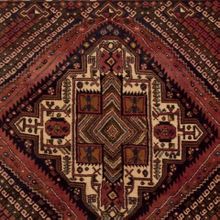Shahr-e-babak Rug
| Shahr-e-babak Rug | |
|---|---|
 Design of Shahr-e-babak Rug (Rugman) | |
| General information | |
| Name | Shahr-e-babak Rug |
| Original name | قالی شهربابک |
| Alternative name(s) | Shahr-e-babak Carpet |
| Origin | |
| Category | Village |
| Technical information | |
| Common designs | Medallion, Geometric, Vase |
| Common colors | Red, Brown, White, Golden, Blue |
| Dyeing method | Natural, Synthetic |
| Pile material | Wool |
| Foundation material | Cotton |
| Knot type | Asymmetrical (Persian) |
From the city of that name in southern Persia, the incredible Kerman carpet is a soft treasure, and among the most beautiful designs woven. The traditional motif has the main border and central medallion in an intricately-detailed, ornate architectural or floral theme in the palest pastels with white-and-gold trim. This typically contrasts with an open field of a rich solid cranberry red, navy blue or other strong colors. Others patterns include the finer Lavar style with garden, tree-of-life, vase and all-over mille fleur designs, or the many pictorials which tell the story of a significant figure or event in history. Silk is almost never used.
History
Materials
Foundation and Pile
Recent weavings have a cotton foundation and a wool pile, but older Shahrbabak rugs were woven with a wool foundation and a wool pile.[1]
Techniques and structures
Color and dyeing
The colors used for the fields are ivory, dark blues, or reds. In addition, blues, browns, greens, yellows, and cinnamon are used in the borders, medallion, and design elements.[2]
Motifs and Designs
The rug designs are geometric, in allover or medallion styles. The rugs show influences from other Kerman Province nomadic carpets, as well as TURKMEN RUGS, Caucasian (CAUCASUS region) rugs, and the BALUCH, LORI, QASHQAI, and SHIRAZ tribes. In general, the medallion weavings have one, two, or three lozenge-shaped devices surrounded by motifs decorated in a parallel style.
The patterns in the field feature floral sprays, Boteh (paisley), Star, and other elements. Shahrbabak allover patterns employ Boteh, French Flower Bouquet, Lattice, Minakhani, Shrub, Star, and other designs. The main borders are narrow, like inany other tribal weavings, and have guard borders on each side. The borders are geometric: repeating flower heads, vines, and leaves, continuous star or tribal motifs are rendered. By the late twentieth century, some Shahrbabak weavers switched from using their traditional tribal designs to making rugs similar to those of other weaving regions in Iran in order to meet domestic and foreign export needs.[3]
Weaving techniques
See also
References
Bibliography
Abraham Levi Moheban, (2015), The Encyclopedia of Antique Carpets: Twenty-Five Centuries of Weaving, NewYork: Princeton Architectural Press.